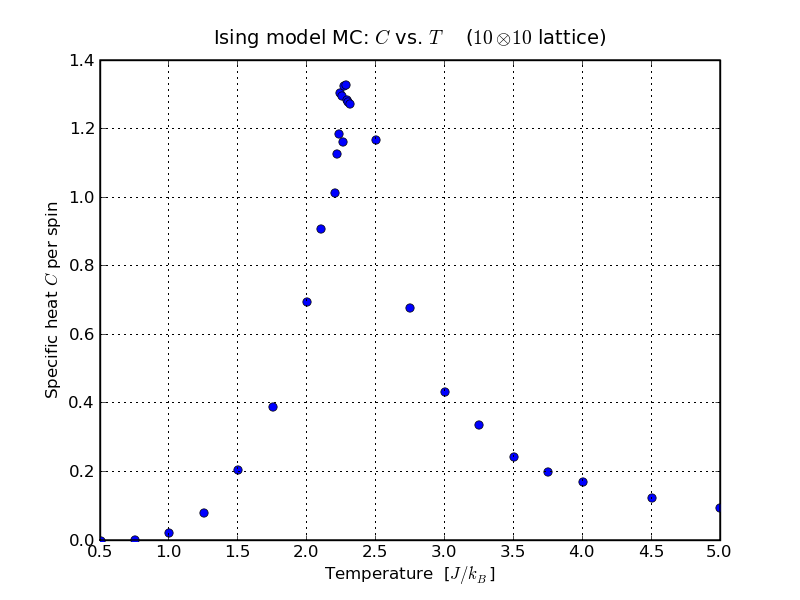Energy
Continuing with the Ising model, each spin in the system will have a certain
energy associated with it. This is dependant on the orientation of the spins
with which it interacts. In a very basic Ising model this is just its nearest
neighbours. The energy of the total system, therefore, can be caluclated as
the sum of the average energy of the constituent spins. This can be
calculated using
N = number of spins and the factor of 1/2 occurs because each pair of spins is couted twice, once where 'spin 1' is considered as 'spin i' and once when it is considered as 'spin j'. The term j in this equation is the number of nearest neighbours with which each spin interacts. In the 2D Ising model case, this number is 4. Also,
\[ \langle E(T\longrightarrow \infty ) \rangle \longrightarrow 0 \,\, ,\]as the disorder in spin alignment increases with temperature. Increasing disorder in spin orientation leads to a more random ratio of 'spin up' to 'spin down'. This results in an average energy and magnetic moment of zero.
The results of a simulation of the Ising model for energy per spin vs temperature is shown below.

The negative energy of the spins in this graph occurs because neighbouring spins tend to align. For any given spin in the lattice, it will have a negative energy if it is pointing in the same direction as its neighbours, and positive if it is in the opposite direction. Therefore, a net negative energy for the lattice implies that more spins are aligned in the same direction as their neighbours than opposing. Despite this, the magnitisation of the material at temperatures above Tc is zero. This means the average magnetic moment of the system is zero; there are the same number of spins pointing 'up' as there are pointing 'down'.
Specific Heat
Specific heat is related to energy very closely as its definition is
For an infinite system, an energy vs temperature diagram, such as the one shown above, shows an infinite discontinuity in the first derivative of energy w.r.t. time at the point Tc. Therefore, from the definition given above, specific heat has an infinite discontinuity at Tc. The behaviour of the system can be described by the power law
\[ C \approx \frac{1}{|T-T_c|^\alpha} \,\, \]which exhibits the divergence at the temperature Tc due to
the inflexion point in the energy. This power law has a
critical exponent α.
The fluctuation-dissipation theorem states that the specific heat can be
related to the variance of the energy squared,
(⟨E2⟩ - ⟨E⟩2), by
The value for ⟨Em⟩ is obtained from sampling
Em during the sweeps of the lattice. From this equation,
the Monte Carlo results for energy vs temperature can be used to estimate
the specific heat. This does indeed yield a peak around Tc,
and the size of this peak increases with lattice size.
The results for this analysis of the specific heat for a 10 × 10 lattice
is shown

It can be seen from the above plot that there is a peak at a temperature around T=2.25. This is the temperature that the phase transition was considered to occur in the previous lecture. This is therefore Tc, a point where there would be an infinite discontinuity, and not simply a peak, if the model did not suffer finite size effects.
Susceptibility
This is the measure of the magnetisation, ⟨M⟩,
that is introduced by a magnetic field, H. This introduces a new
variable, an external field, as previously we have only considered
spontaneous magnetisation.
Again, the fluctuation-dissipation theorem can be applied, this time introducing a dependancy of the susceptibility on the variance of the magnetisation. This relationship is
The value for ⟨Mm⟩ is obtained from sampling
Mm during the sweeps of the lattice.
χ, in fact, also diverges for the condition
T → Tc.
This is described by another power law with a critical exponent
γ.
This enables us to investigate how the system would react to an external
field without it becoming necessary to actually apply one.